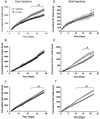Chronic suppression of μ-opioid receptor signaling in the nucleus accumbens attenuates development of diet-induced obesity in rats
- PMID: 20065959
- PMCID: PMC2885588
- DOI: 10.1038/ijo.2009.297
Chronic suppression of μ-opioid receptor signaling in the nucleus accumbens attenuates development of diet-induced obesity in rats
Abstract
Objective: To test the hypothesis that micro-opioid receptor signaling in the nucleus accumbens contributes to hedonic (over)eating and obesity. To investigate the effects of chronic micro-opioid antagonism in the nucleus accumbens core or shell on intake of a palatable diet, and the development of diet-induced obesity in rats.
Methods and design: Chronic blockade of micro-opioid receptor signaling in the nucleus accumbens core or shell was achieved by means of repeated injections (every 4-5 days) of the irreversible receptor antagonist beta-funaltrexamine (BFNA) over 3-5 weeks. The diet consisted of either a choice of high-fat chow, chocolate-flavored Ensure and regular chow (each nutritionally complete) or regular chow only. Intake of each food item, body weight and body fat mass were monitored throughout the study.
Results: The BFNA injections aimed at either the core or shell of the nucleus accumbens resulted in significantly attenuated intake of palatable diet, body weight gain and fat accretion, compared with vehicle control injections. The injection of BFNA in the core did not significantly change these parameters in chow-fed control rats. The injection of BFNA in the core and shell differentially affected intake of the two palatable food items: in the core, BFNA significantly reduced the intake of high-fat, but not of Ensure, whereas in the shell, it significantly reduced the intake of Ensure, but not of high-fat, compared with vehicle treatment.
Conclusions: Endogenous micro-opioid receptor signaling in the nucleus accumbens core and shell is necessary for palatable diet-induced hyperphagia and obesity to fully develop in rats. Sweet and non-sweet fatty foods may be differentially processed in subcomponents of the ventral striatum.
Conflict of interest statement
The authors have no conflict of interest to declare
Figures






Similar articles
-
Mu opioid receptor antagonism in the nucleus accumbens shell blocks consumption of a preferred sucrose solution in an anticipatory contrast paradigm.Neuroscience. 2014 Mar 7;261:144-52. doi: 10.1016/j.neuroscience.2013.12.004. Epub 2013 Dec 14. Neuroscience. 2014. PMID: 24342569 Free PMC article.
-
Reversible suppression of food reward behavior by chronic mu-opioid receptor antagonism in the nucleus accumbens.Neuroscience. 2010 Oct 13;170(2):580-8. doi: 10.1016/j.neuroscience.2010.07.017. Epub 2010 Jul 27. Neuroscience. 2010. PMID: 20654704 Free PMC article.
-
General, kappa, delta and mu opioid receptor antagonists mediate feeding elicited by the GABA-B agonist baclofen in the ventral tegmental area and nucleus accumbens shell in rats: reciprocal and regional interactions.Brain Res. 2012 Mar 14;1443:34-51. doi: 10.1016/j.brainres.2012.01.015. Epub 2012 Jan 17. Brain Res. 2012. PMID: 22305145
-
From taste hedonics to motivational drive: central μ-opioid receptors and binge-eating behaviour.Int J Neuropsychopharmacol. 2009 Aug;12(7):995-1008. doi: 10.1017/S146114570900039X. Epub 2009 May 12. Int J Neuropsychopharmacol. 2009. PMID: 19433009 Review.
-
Preference or fat? Revisiting opioid effects on food intake.Physiol Behav. 2010 Jul 14;100(5):429-37. doi: 10.1016/j.physbeh.2010.02.027. Epub 2010 Mar 4. Physiol Behav. 2010. PMID: 20211638 Free PMC article. Review.
Cited by
-
Current research on opioid receptor function.Curr Drug Targets. 2012 Feb;13(2):230-46. doi: 10.2174/138945012799201612. Curr Drug Targets. 2012. PMID: 22204322 Free PMC article. Review.
-
Manipulation of GABA in the ventral pallidum, but not the nucleus accumbens, induces intense, preferential, fat consumption in rats.Behav Brain Res. 2014 Aug 15;270:316-25. doi: 10.1016/j.bbr.2014.05.032. Epub 2014 May 24. Behav Brain Res. 2014. PMID: 24867334 Free PMC article.
-
Suppressed Fat Appetite after Roux-en-Y Gastric Bypass Surgery Associates with Reduced Brain μ-opioid Receptor Availability in Diet-Induced Obese Male Rats.Front Neurosci. 2017 Jan 13;10:620. doi: 10.3389/fnins.2016.00620. eCollection 2016. Front Neurosci. 2017. PMID: 28133443 Free PMC article.
-
Individual Differences in Cue-Induced Motivation and Striatal Systems in Rats Susceptible to Diet-Induced Obesity.Neuropsychopharmacology. 2015 Aug;40(9):2113-23. doi: 10.1038/npp.2015.71. Epub 2015 Mar 12. Neuropsychopharmacology. 2015. PMID: 25761571 Free PMC article.
-
Hormonal and neural mechanisms of food reward, eating behaviour and obesity.Nat Rev Endocrinol. 2014 Sep;10(9):540-52. doi: 10.1038/nrendo.2014.91. Epub 2014 Jun 24. Nat Rev Endocrinol. 2014. PMID: 24958311 Review.
References
-
- Hill JO, Wyatt HR, Reed GW, Peters JC. Obesity and the environment: where do we go from here? Science. 2003;299:853–855. - PubMed
-
- Wyatt SB, Winters KP, Dubbert PM. Overweight and obesity: prevalence, consequences, and causes of a growing public health problem. Am J Med Sci. 2006;331:166–174. - PubMed
-
- Weinsier RL, Hunter GR, Heini AF, Goran MI, Sell SM. The etiology of obesity: relative contribution of metabolic factors, diet, and physical activity. Am J Med. 1998;105:145–150. - PubMed
-
- Farooqi IS, Keogh JM, Yeo GS, Lank EJ, Cheetham T, O'Rahilly S. Clinical spectrum of obesity and mutations in the melanocortin 4 receptor gene. N Engl J Med. 2003;348:1085–1095. - PubMed
Publication types
MeSH terms
Substances
Grants and funding
LinkOut - more resources
Full Text Sources
Medical
Research Materials

